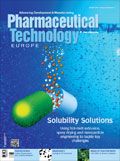Tackling Solubility Issues
Dedong Wu, senior scientist at AstraZeneca, explains how nanoparticle engineering and crystal engineering can aid solubility.
Why has nanoparticle engineering become an important strategy for tackling solubility, stability and other drug delivery challenges?
Wu: For poorly soluble drug candidates, various enabling techniques have been used to enhance the apparent solubility and dissolution rate. Bioavailability can benefit from a higher API concentration achieved by the formation of a supersaturated solution. However, some compounds exhibit very fast crystallisation and it is extremely difficult to inhibit this property from a compound’s meta-stable solid-state form (e.g., amorphous or solid dispersions) during shelf-life periods. Moreover, these compounds will quickly precipitate and/or crystallise in the body, which can significantly reduce the in vivo drug concentration leading to poor drug efficacy.
Nanoparticle engineering is an alternative method for such compounds in a formulation that uses the special physical property of nanoparticles. The high-surface area to volume ratio of nanoparticles provides a tremendous driving force for diffusion so that nanoparticles of a poorly soluble compound can be distributed as nano-sized particles in the body, thereby avoiding crystallisation or precipitate issues. The smaller size helps to improve the surface–volume ratio of drug candidates, increasing the dissolution rate and improving API bioavailability.
What advantages does nanoparticle engineering offer over other approaches being used to address solubility and drug delivery issues?
Wu: Several commercialised nanoparticle drug products have successfully demonstrated that nanoparticle engineering can increase bioavailability and improve pharmacokinetic profile, reducing the frequency of dosing. Furthermore, food–drug interactions (the food effect) can be reduced because the pharmacokinetic profile of nanoparticle formulations are not affected by the Fed and Fasted state, as exampled by the cholesterol lowering drug, TriCor (Abbott Laboratories). By using nanoparticle technology, Janssen’s Invega Sustenna (Xeplion in Europe) became the first once-monthly atypical antipsychotic medicine approved for schizophrenia in the US. All of these advantages were achieved using nanocrystal technology. Various nanocarrier techniques have also been used to provide extra benefits in controlled release and targeting delivery.
What popular nanoparticle approaches are currently being exploited by researchers and pharmaceutical companies as part of efforts to improve drug solubility?
Wu: Two different nanoparticle approaches, nanocrystals and nanocarriers, are being well used by researchers and pharmaceutical companies. The nanocrystals technique involves decreasing the particle size of a crystalline drug to improve the bioavailability. Nanocrystals are one of the most successful nanoparticle approaches used so far, evidenced by several commercial drug products, including Pfizer’s Rapamune, Merck and Co’s Emend, Abbott Laboratories’s TriCor, and Janssen’s Invega Sustenna. They are also a popular method for proof-of-concept studies, with laboratory-milling equipment and ultrasonic assisted methods being introduced into laboratories specifically for nanoparticle preparations.
Nanocarriers can be used to deliver drugs more effectively to targeted cells. The use of liposomes is well established in drug-delivery applications and polymer-based nanocarriers have progressed enormously in recent years, with several applications demonstrating advantages in targeting delivery, such as Regulon’s Lipop (Liposomal Cisplatin), Cerulean’s CRLX288 (biodegradable polymeric nanoparticle conjugated to docetaxel and BIND’s Accurin technique for BIND-014 docetaxel.
How are advances in nanoparticle engineering and crystal engineering being combined to tackle the challenges of poor solubility? What new techniques are emerging that show promise in this area?
Wu: There are two emerging techniques showing promise in the field of nanocrystal techniques. Nanococrystals combines nanoparticle engineering and crystal engineering for the formulation of nanoparticles. Conventional nanocrystals technology usually focuses on improving the dissolution rate to enhance bioavailability. Amorphous nanoparticle engineering has also been studied to increase API concentration. However, the use of nanoparticles of the amorphous drug in the formulation needs to overcome the challenge in stabilising the amorphous form during both manufacture and the shelf life of the drug product. Nanococrystal application can potentially increase API concentration without creating disadvantages in the stability and powder properties of the amorphous form. Another emerging application to the nanocystals technique is the layer-by-layer coating technique applied to nanoparticles. Coated nanoparticles will not only improve particle stability, but also offer the possibility of designing nanopaticle surfaces that can achieve controlled release and targeted delivery.

Drug Solutions Podcast: A Closer Look at mRNA in Oncology and Vaccines
April 30th 2024In this episode fo the Drug Solutions Podcast, etherna’s vice-president of Technology and Innovation, Stefaan De Koker, discusses the merits and challenges of using mRNA as the foundation for therapeutics in oncology as well as for vaccines.